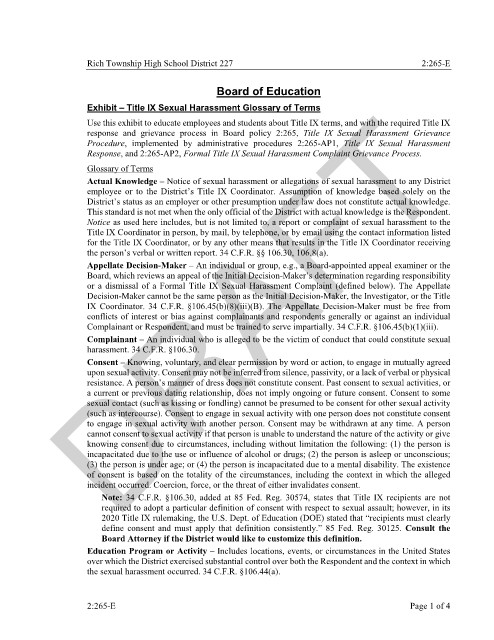Page 727 - Draft
P. 727
Rich Township High School District 227 2:265-E
Board of Education
DRAFT
Exhibit – Title IX Sexual Harassment Glossary of Terms
Use this exhibit to educate employees and students about Title IX terms, and with the required Title IX
response and grievance process in Board policy 2:265, Title IX Sexual Harassment Grievance
Procedure, implemented by administrative procedures 2:265-AP1, Title IX Sexual Harassment
Response, and 2:265-AP2, Formal Title IX Sexual Harassment Complaint Grievance Process.
Glossary of Terms
Actual Knowledge – Notice of sexual harassment or allegations of sexual harassment to any District
employee or to the District’s Title IX Coordinator. Assumption of knowledge based solely on the
District’s status as an employer or other presumption under law does not constitute actual knowledge.
This standard is not met when the only official of the District with actual knowledge is the Respondent.
Notice as used here includes, but is not limited to, a report or complaint of sexual harassment to the
Title IX Coordinator in person, by mail, by telephone, or by email using the contact information listed
for the Title IX Coordinator, or by any other means that results in the Title IX Coordinator receiving
the person’s verbal or written report. 34 C.F.R. §§ 106.30, 106.8(a).
Appellate Decision-Maker – An individual or group, e.g., a Board-appointed appeal examiner or the
Board, which reviews an appeal of the Initial Decision-Maker’s determination regarding responsibility
or a dismissal of a Formal Title IX Sexual Harassment Complaint (defined below). The Appellate
Decision-Maker cannot be the same person as the Initial Decision-Maker, the Investigator, or the Title
IX Coordinator. 34 C.F.R. §106.45(b)(8)(iii)(B). The Appellate Decision-Maker must be free from
conflicts of interest or bias against complainants and respondents generally or against an individual
Complainant or Respondent, and must be trained to serve impartially. 34 C.F.R. §106.45(b)(1)(iii).
Complainant – An individual who is alleged to be the victim of conduct that could constitute sexual
harassment. 34 C.F.R. §106.30.
Consent – Knowing, voluntary, and clear permission by word or action, to engage in mutually agreed
upon sexual activity. Consent may not be inferred from silence, passivity, or a lack of verbal or physical
resistance. A person’s manner of dress does not constitute consent. Past consent to sexual activities, or
a current or previous dating relationship, does not imply ongoing or future consent. Consent to some
sexual contact (such as kissing or fondling) cannot be presumed to be consent for other sexual activity
(such as intercourse). Consent to engage in sexual activity with one person does not constitute consent
to engage in sexual activity with another person. Consent may be withdrawn at any time. A person
cannot consent to sexual activity if that person is unable to understand the nature of the activity or give
knowing consent due to circumstances, including without limitation the following: (1) the person is
incapacitated due to the use or influence of alcohol or drugs; (2) the person is asleep or unconscious;
(3) the person is under age; or (4) the person is incapacitated due to a mental disability. The existence
of consent is based on the totality of the circumstances, including the context in which the alleged
incident occurred. Coercion, force, or the threat of either invalidates consent.
Note: 34 C.F.R. §106.30, added at 85 Fed. Reg. 30574, states that Title IX recipients are not
required to adopt a particular definition of consent with respect to sexual assault; however, in its
2020 Title IX rulemaking, the U.S. Dept. of Education (DOE) stated that “recipients must clearly
define consent and must apply that definition consistently.” 85 Fed. Reg. 30125. Consult the
Board Attorney if the District would like to customize this definition.
Education Program or Activity – Includes locations, events, or circumstances in the United States
over which the District exercised substantial control over both the Respondent and the context in which
the sexual harassment occurred. 34 C.F.R. §106.44(a).
2:265-E Page 1 of 4

